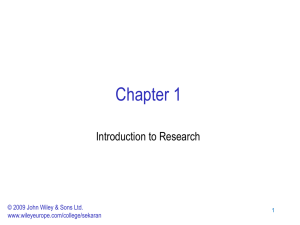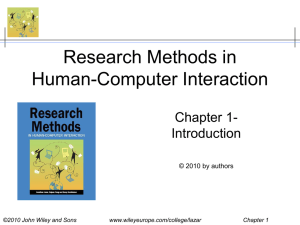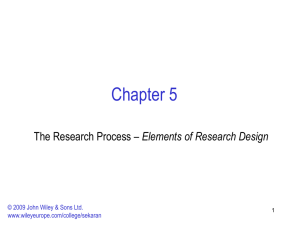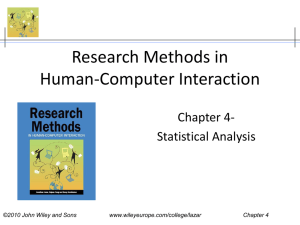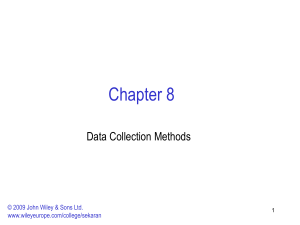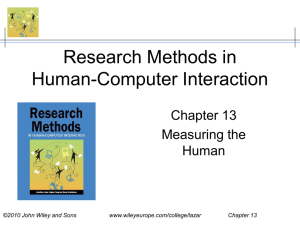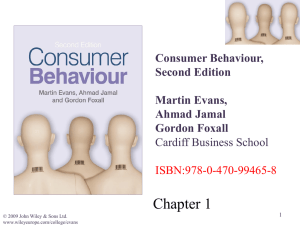ch11 - Interactive Computing Lab
advertisement
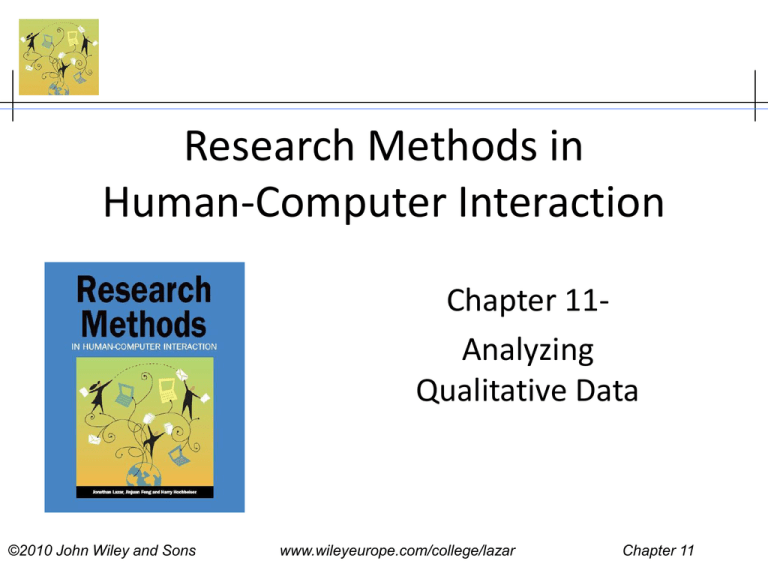
Research Methods in Human-Computer Interaction Chapter 11Analyzing Qualitative Data ©2010 John Wiley and Sons www.wileyeurope.com/college/lazar Chapter 11 Overview • • • • • • Introduction Stages of qualitative analysis Grounded theory Content analysis Analyzing text content Analyzing multimedia content ©2010 John Wiley and Sons www.wileyeurope.com/college/lazar Chapter 11 Stages of qualitative analysis • Identify components of the substance • Study properties and dimensions of each component • Understand and make inference about the substance ©2010 John Wiley and Sons www.wileyeurope.com/college/lazar Chapter 11 Grounded theory • An inductive research method ©2010 John Wiley and Sons www.wileyeurope.com/college/lazar Chapter 11 Procedures of grounded theory • • • • open coding development of concepts grouping concepts into categories formation of a theory ©2010 John Wiley and Sons www.wileyeurope.com/college/lazar Chapter 11 Grounded theory • Advantages – a systematic approach to analyzing qualitative, mostly text-based, data, – generating theory out of qualitative data that can be backed up by ample evidence of the coding – Interplay between data collection and analysis ©2010 John Wiley and Sons www.wileyeurope.com/college/lazar Chapter 11 Grounded theory • Disadvantages – Researcher can be overwhelmed by the details of the data – The theory generated is hard to evaluate – Findings may be subject to bias ©2010 John Wiley and Sons www.wileyeurope.com/college/lazar Chapter 11 Content analysis • A more specific view: a systematic, replicable technique for compressing many words of text into fewer content categories based on explicit rules of coding • A broader view: any technique for making inferences by objectively and systematically identifying specified characteristics of messages ©2010 John Wiley and Sons www.wileyeurope.com/college/lazar Chapter 11 Content categories ©2010 John Wiley and Sons www.wileyeurope.com/college/lazar Chapter 11 Preparing for content analysis • • • • Define the data set Define the population Clean up the data Understand the context of the data ©2010 John Wiley and Sons www.wileyeurope.com/college/lazar Chapter 11 Analyzing text data • A priori coding – Identify coding categories – Coding – Reliability check • Emergent coding – – – – – – Multiple coders identify coding categories based on subset of data Consolidate category list Code a subset of data Reliability check Repeat the process until satisfactory result is met Code the rest of the data ©2010 John Wiley and Sons www.wileyeurope.com/college/lazar Chapter 11 Identify coding categories • • • • Theoretical framework Researcher-denoted concepts In-vivo codes Building a code structure (nomenclature) ©2010 John Wiley and Sons www.wileyeurope.com/college/lazar Chapter 11 Coding the text • Look for key items ©2010 John Wiley and Sons www.wileyeurope.com/college/lazar Chapter 11 Coding the text • Ask questions about the data • Making comparisons – Between different coding category – Between different participant group – Between existing data and previous literature • Using computer software ©2010 John Wiley and Sons www.wileyeurope.com/college/lazar Chapter 11 Ensure high quality analysis • Validity – constructing a multi-faceted argument in favor of your interpretation of the data – Constructing a database – Data source triangulation – Interpretation should account for as much as possible of the data – Alternative interpretations may also help ©2010 John Wiley and Sons www.wileyeurope.com/college/lazar Chapter 11 Ensure high quality analysis • Reliability check – Stability • also called intra-coder reliability • examines whether the same coder rates the data in the same way throughout the coding process – Reproducibility • also called inter-coder reliability or investigator triangulation • examines whether different coders code the same data in a consistent way ©2010 John Wiley and Sons www.wileyeurope.com/college/lazar Chapter 11 Reliability measures • Percent agreement Number of cases coded the same way % Agreement = Total number of cases • Cohen’s Kappa: K = (Pa − Pc)/(1 − Pc) ©2010 John Wiley and Sons www.wileyeurope.com/college/lazar Chapter 11 Reliability check • Agreement matrix ©2010 John Wiley and Sons www.wileyeurope.com/college/lazar Chapter 11 Reliability check • Interpretation of Cohen’s Kappa ©2010 John Wiley and Sons www.wileyeurope.com/college/lazar Chapter 11 Subjective vs. objective coder • Subjective coders – Knowledge and experience can help interpret the data – Less training required – May cause inflated reliability • Objective coders – Less likely to cause inflated reliability – Lack of knowledge affect the ability to understand the data – More training required ©2010 John Wiley and Sons www.wileyeurope.com/college/lazar Chapter 11 Analyzing multimedia content • The supporting techniques and methods are less mature compared to text data analysis • Approaches: – Manual analysis: • highly labor intensive and time consuming • More accurate – Completely automated analysis: • Faster, less amount of work • Highly inaccurate – Partially automated approach • Combines the advantages of the manual process and the completely automated process ©2010 John Wiley and Sons www.wileyeurope.com/college/lazar Chapter 11 End-of-chapter • Summary • Discussion questions • Research design exercise ©2010 John Wiley and Sons www.wileyeurope.com/college/lazar Chapter 11

